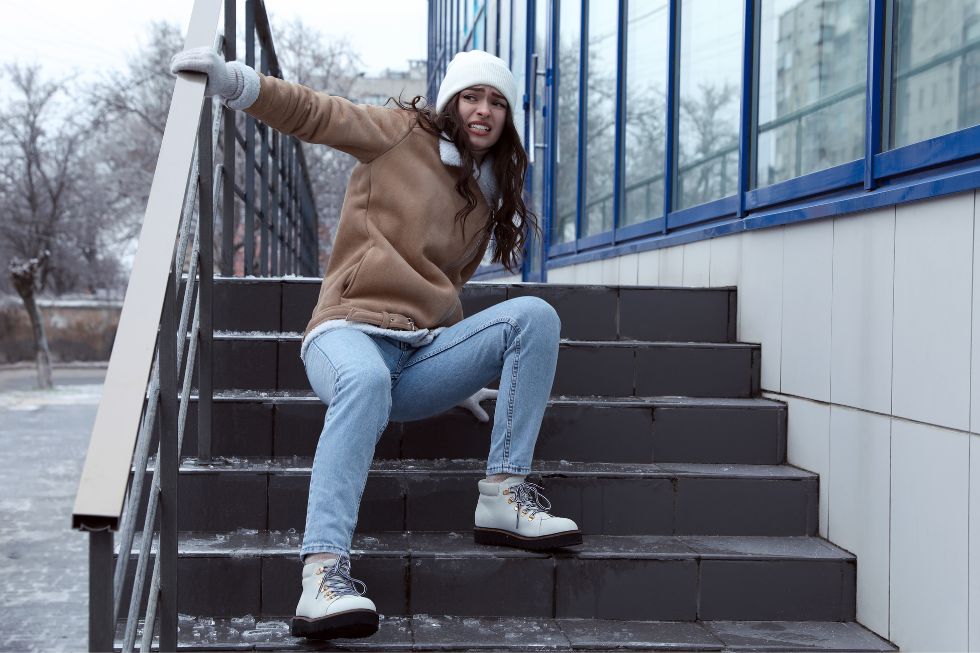Broken bones. Chronic pain. Traumatic brain injury. Paralysis. These are only a few of the injuries you can sustain because of a slip and fall.
Slip and fall injuries don’t just cause short-term pain and suffering. They can also carry a severe financial burden in the form of expensive medical bills, lost wages during recovery, and loss of future income as a result of any permanent disability.
Maybe you have recently been injured in a slip and fall. If so, let’s cover the basics so you’ll know whether you have grounds to file a personal injury claim for a slip and fall.
Be advised that Minnesota has established a very short, (two year) limitation period for filing a case due to an injury sustained due to a defect in real property. (Real estate or the buildings upon the real estate).
What Is a Slip and Fall Injury?
Duty. Breach. Causation. Damages. These are the four prerequisites for a personal injury claim. For example:
-
Duty. The owner, landlord or manager of a private property (defendant) has a duty to fix hazardous on-site conditions, as well as warn visitors when hazardous conditions are present. (Business owners have an affirmative duty to inspect the property for potentially hazardous conditions).
-
Breach. The defendant fails to fix a hazard, or warn of its existence.
-
Causation. A visitor to the property (plaintiff) has an accident as a direct result of the hazard’s existence.
-
Damages. The plaintiff becomes injured as a direct result of the accident.
Let’s see how those same standards are met during a hypothetical slip and fall incident.
-
Duty. The manager of a store has a duty to provide safe premises to the general public.
-
Breach. The store manager is aware of a leak in the ceiling but fails to repair it or take reasonable steps to prevent visitors from walking across the puddle it creates.
-
Causation. A visitor, unaware of the hazard, slips on the puddle and falls.
-
Damages. The visitor fractures bones as a direct result of their fall.
This is only one specific example of a slip and fall injury. In addition to wet floors, several other types of hazards can cause slip and fall injuries on private property, such as:
|
|
|
|
|
|
|
|
|
|
|
|
Where Can Slip and Fall Injuries Occur?
You cannot file a personal injury claim for a slip and fall injury you sustain in your own home. Your homeowners policy may cover you if a visitor to your home slips and falls. But your homeowner’s insurance excludes coverage for injuries to the insured residents. (Note that you may still file a claim for occurring within your home if, for example, the source of the injury was a defective product.)
It is much more difficult to file a personal injury claim against the United States government, or a state government. Sovereign immunity provides governmental entities many protections, unavailable to private citizens. A plaintiff may still file a lawsuit against a city if it was responsible for creating the unsafe conditions (for example, allowing snow melt off to be routed, by a poorly placed downspout, across a sidewalk, on a recurring basis). which led to their slip and fall, although the process is somewhat more complicated.
With those possible exceptions aside, you may file a claim after suffering a slip and fall on any privately or municipally owned property. Here are just some of the sites where slip and fall claims frequently originate:
-
Sidewalks – Laws may vary in other areas, although most municipalities in Minnesota require property owners to keep the sidewalks abutting their properties safe for public travel. That includes removing ice and snow from the sidewalks. Their failure to do so could result in a claim.
-
Bars and restaurants – Restaurant managers are well aware that dropped food and drinks can create serious slipping hazards. A visitor who slips on a hazard that was created only seconds earlier may encounter difficulty reaching a settlement, but dining establishments that fail to clean spills after several minutes generally have a weaker defense against claims of negligence. (Proving the business had adequate notice to remedy, and failed to do so, is key).
-
Stores – Grocery stores are filled with potential slipping hazards, although they aren’t the only retail locations where slip and fall injuries take place. Any store with a freshly waxed floor, loose or uneven flooring, or a floor that is cluttered with unsold inventory may neglect its duty to protect its patrons against injury.
-
Residential properties – Landlords have just as much obligation to prevent slip and fall hazards as any other private property owner. And although a homeowner wouldn’t be compensated for a slip and fall injury they sustained on their own property, their homeowners’ policy includes liability coverage that would take effect if the homeowner’s negligence (lack of reasonable care) caused a visitor to suffer a slip and fall injury.
Slip and fall settlements aren’t guaranteed. Tort law is extremely nuanced, and certain protocol must be followed if a plaintiff is to file a successful personal injury claim. If you have become the victim of a slip and fall injury in the state of Minnesota and believe you are owed compensation for your pain and financial losses, then we welcome you to contact Kiernan Personal Injury Attorneys today for a free, zero-obligation consultation. We fight for our clients’ rights every day!

Recent Comments